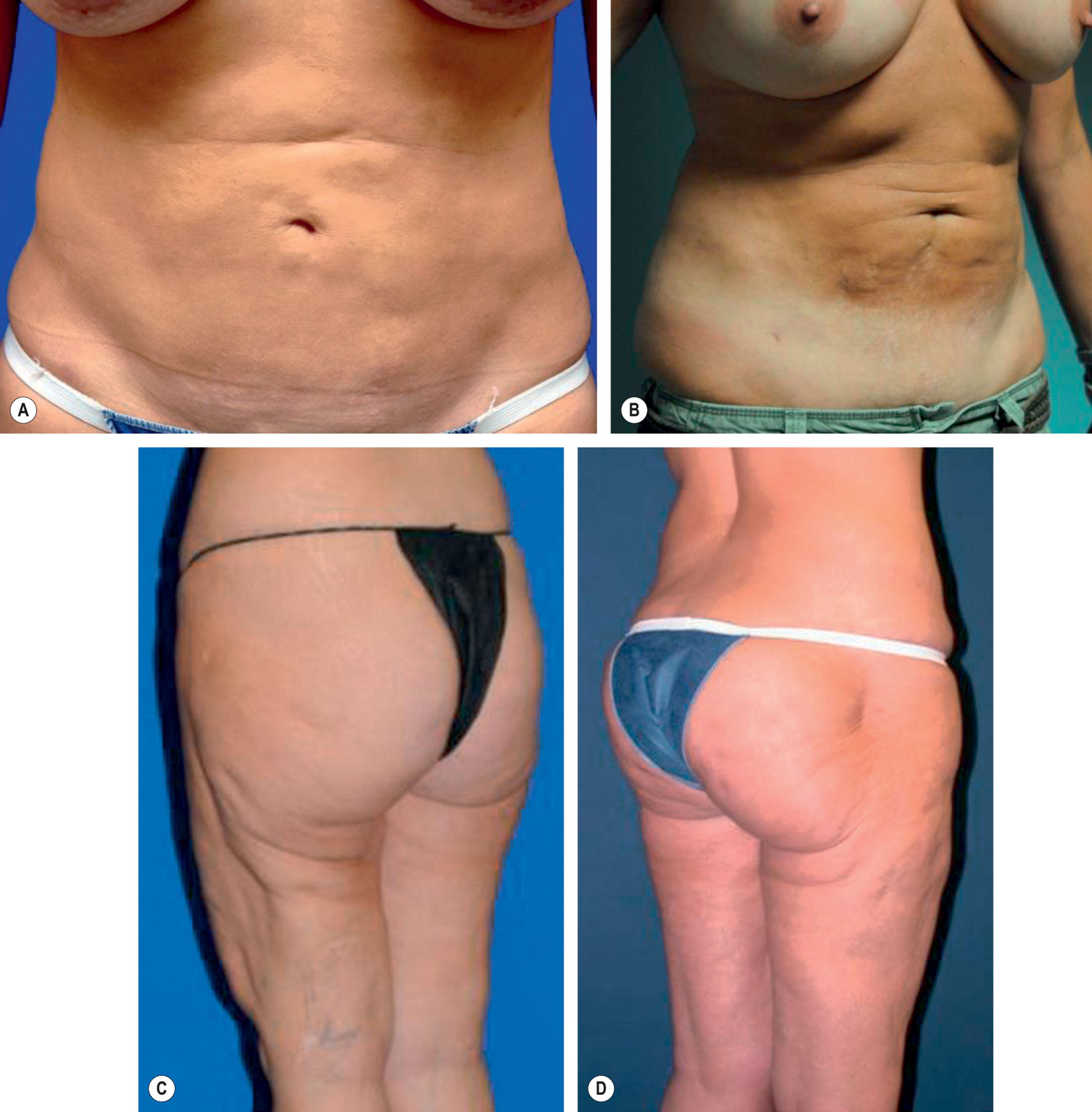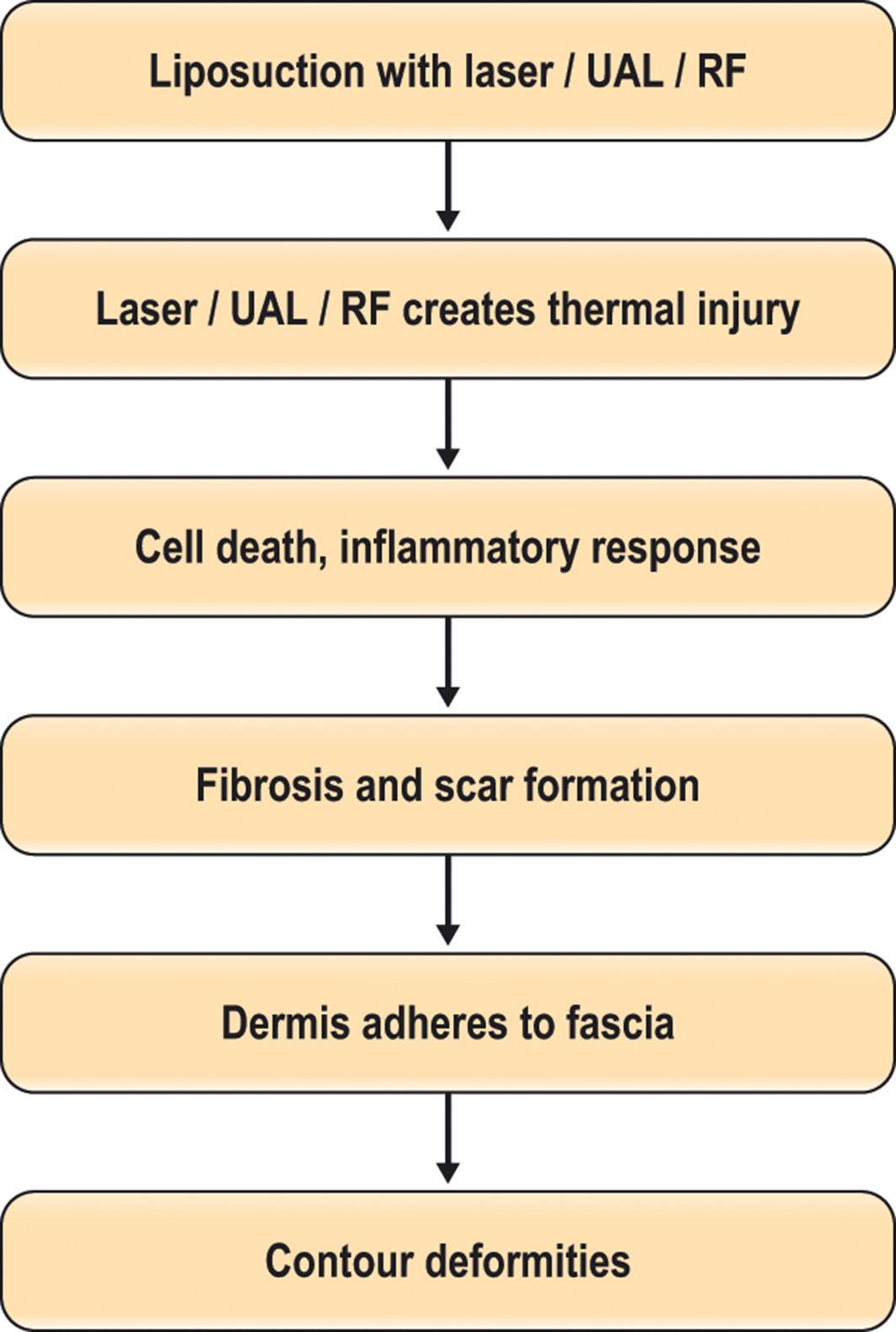Physical Address
304 North Cardinal St.
Dorchester Center, MA 02124
Liposuction is growing in popularity and technological sophistication but sometimes results require revision.
Revision and secondary liposuction differ. Although much of the information in this chapter pertains to both procedures, the focus will be on secondary procedures.
When considering repeat liposuction, surgeons must accept that the result will never be as good as could have been achieved from an optimally performed primary liposuction, and the risk of serious injury is greater.
In repeat liposuction, resistance may be due to an undesirable structure but could also be fibrotic subcutaneous tissue secondary to scarring.
The loss of differential resistance in repeat liposuction is the primary reason that it is fraught with complications.
SAFE is an acronym for S eparation, A spiration, and F at E qualization.
In repeat cases, a fourth step is frequently added that can include fat shifting, fat grafting, and release processes to address any residual defects or volume deficiencies.
Access video lecture content for this chapter online at Elsevier eBooks+ ![]()
Liposuction is growing in popularity and technological sophistication. It has become safer, faster, more effective, and more predictable. Surgeons performing liposuction understand the anatomy of fat and fluid management better. Advances in instrumentation and technique yield more predictable outcomes with less disruption of vascularity. However, sometimes the results require revision.
Revision and secondary liposuction differ. Revision is a repeat operation typically performed by the same surgeon to improve the initial result, or deal with something not or suboptimally addressed in the primary procedure. Secondary liposuction is frequently performed by a different surgeon, and is usually far more extensive than a revision. Secondary procedures are usually performed more than a year after the initial procedure, whereas revision procedures may fall within a year of the original surgery. Although much of the information in this chapter pertains to both procedures, the focus will be on secondary procedures, both types falling under the more generalized term of repeat liposuction.
An unfavorable result may not be the only reason patients present for repeat liposuction. Many patients request repeat procedures for further reduction of an area already treated, having either gained weight or simply wanting further contouring of the area. Most commonly, however, patients are dissatisfied with contour deformities from the initial procedure. These can range from skin waviness, to divots and depressions. Patients can also have skin damage associated with these deformities in the form of hemosiderin deposition, pigmentary changes, and scarring from thermal or avulsive techniques. Internal scarring causes tethering, tightness, and a worsening appearance with positional changes or skin tension. External scarring is typically seen with thermal liposuction, leading to entry site burns or internal burns to the overlying skin, but can also be seen from non-thermal means, as a result of overaggressive or avulsive liposuction that devascularized the overlying skin ( Fig. 25.3.1 ).

Many surgeons avoid repeat liposuction altogether. However, when considering repeat liposuction, surgeons must accept (1) the result will never be as good as could have been achieved from an optimally performed primary liposuction, and (2) the risk of serious injury is greater.
Several factors contribute to the difficulty of repeat liposuction. Liposuction itself hinges on the premise that there is a relatively low-resistance, subcutaneous adipose layer between the higher-resistance overlying superficial fat and dermis and the underlying musculoskeletal structures. Fat is less dense and easier to disrupt than most surrounding tissues. Once this plane has been manipulated or disrupted, it becomes scarred and adherent, rendering navigation more difficult. For example, in primary liposuction, when significant resistance is encountered at the tip of the cannula, it generally indicates that an unwanted structure has been encountered and the cannula should be redirected. In repeat liposuction, resistance may be due to an undesirable structure, but could also be fibrotic subcutaneous tissue secondary to scarring. The surgeon must be able to discern the cause of this resistance and determine whether to continue with the high-resistance pass or stop and redirect.
The loss of differential resistance in repeat liposuction is the primary reason that this is fraught with complications such as skin “end hits”. This is due to the surgeon's tendency to redirect the cannula superficially, preferring to err superficially rather than into deeper, more vital structures. Loss of the low-resistance plane can also result in potentially fatal abdominal perforation or damage to deeper structures. Cannula injury to skin and body structures, vascular disruption, major bleeding, musculoskeletal injury, and internal organ perforation have all been reported and are underreported in the literature. While these injuries are possible with any liposuction, they are far more likely to occur in repeat liposuction due to increased tissue resistance and scarred, confluent tissue beds that require more passes of the cannula with greater force.
The dose–response curve is applicable to liposuction, wherein the dose is the amount of fat removed and the response is subcutaneous irregularities until a threshold of contour deformity is reached. Despite considerable progress, including better safety in large-volume liposuction, no technologies introduced thus far have been able to break this “dose–response curve”.
The introduction of many internal thermal technologies over the years has compounded this dose–response curve with the addition of the thermal load on the tissues, contributing further to inflammation and fibrosis.
Repeat liposuction is usually significantly longer than primary procedures, due to scarring and the necessity of more passes to obtain a smooth result. Because the duration of liposuction is also directly related to fat removal, the prolonged duration further increases the likelihood of creating contour deformities due to excess fat removal. Frequently, repeat liposuction patients also require fat grafting, adding both complexity and additional procedure time. For all of these reasons, the method of liposuction utilized for both primary and secondary cases is crucial to obtaining satisfactory results.
In traditional liposuction, the dose–response curve refers to the propensity toward contour deformities as the amount of fat removal increases. Thermal methods of liposuction (laser, ultrasonic, radiofrequency, and others) can cause contour deformities related to thermal injury varying with the type and power of the device. Furthermore, thermal injury caused by these devices is not restricted to targeted fat, but may affect untargeted fat, as well as the supporting stromal network of tissue ( Figs. 25.3.2 & 25.3.3 ).


Particularly in repeat cases, fibrotic tissues require longer treatment times. This is associated with more thermal damage, fibrosis, scar formation, and often more contour deformities. For these reasons, the senior author has abandoned internal thermal liposuction technologies and opted to use strictly fat-preserving techniques for all cases ( Fig. 25.3.4 ).

Two paradigms are proposed for treating fat in body contouring. In fat grafting, effort focuses on optimal graft survival by maintaining a healthy recipient bed through preservation of supporting structures and vascularity. In contrast, in liposuction, the paradigm seems to be removal of fat with little regard for supporting structures. On one hand, the recipient bed is treated as delicately as possible, while on the other, liposuctioned fat and its bed are treated differently. Non-selective fat removal can be destructive to supporting structures while lending itself to contour deformities and increasing complexity of revision. Therefore, we believe in a single, comprehensive paradigm in treating fat: to augment, redistribute, or reduce to a desired contour, while preserving the remaining fat and surrounding structures.
Many of the indications and contraindications for repeat liposuction are similar to those for primary liposuction. Good candidates have a body mass index (BMI) of 30 or below, good diet and exercise habits, and have reasonable expectations. In patients seeking repeat liposuction due to the re-accumulation of fat, these factors become even more important.
Patients who were not adherent to their initial postoperative care regimen, or who quickly gained weight following previous surgery, may not be ideal for a repeat procedure. Sometimes, patients requesting repeat procedures may not have had a previous positive experience. In these situations, one must explain the risks, benefits, and limitations of a secondary procedure. Unreasonable expectations (i.e., those unlikely to be achieved by available techniques) are a contraindication.
It is recommended to wait at least 1 year and sometimes longer prior to performing a secondary procedure. This time is needed for the resolution of all swelling so that tissues are optimally soft, pliable, and elastic. Furthermore, a stable bed is necessary for the addition, redistribution, and subtraction of fat. Typically, the longer the time interval between the original surgery and the repeat operation, the better the chances for successful improvement.
Become a Clinical Tree membership for Full access and enjoy Unlimited articles
If you are a member. Log in here